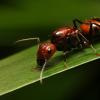Title:
1. Location of collection: Hawaii, USA
2. Today's date: Monday, Jan 16, 2017, 7:51 pm
Body:
1. Location of collection: Kailua Club Tennis Courts, Oahu, Hawaii, USA
2. Date of collection: August 13, 2016, 8:00 pm
3. Habitat of collection: Tennis Court
4. Length (to the nearest millimeter or 1/16th of an inch.): 5mm
5. Coloration, hue, pattern and texture: Head and thorax dull brown/red, abdomen shiny black.
6. Distinguishing characteristics: 2 petiole nodes, no visible spines, roughly triangle/oval shape head, similar to a tetramorium head. Eyes relatively medium sized, mandibles 1/4 length of head and sort of a triangle shape, antennal segments unapparent.
7. Anything else distinctive: no odor, relatively active, eats eggs, no workers seen
8. Nest description: no nest found
Pics:


As some of you may know, I found this queen quite a while ago and identified her as a semi-claustral tetramorium. She still has no eggs or larvae that she hasn't eaten. I wonder if I am keeping her wrong. Does anyone know what queen she actually is and how to care for her? thanks!




















